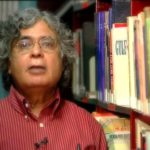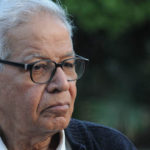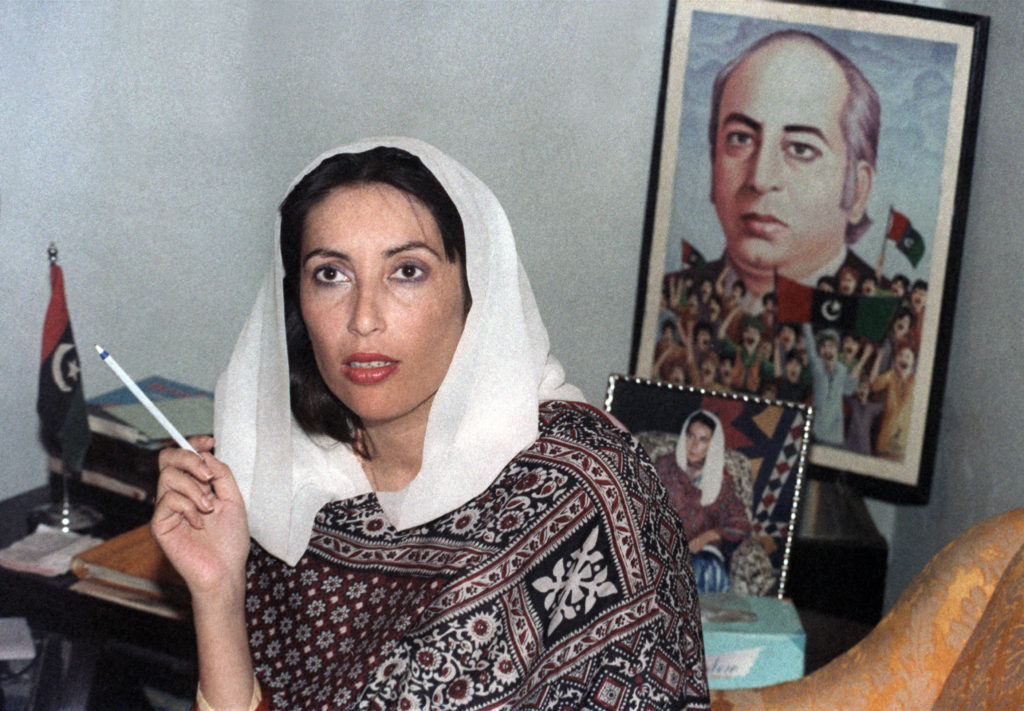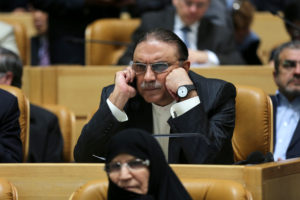Is the PPP Done and Dusted?
By Newsline Admin | Viewpoint | Published 8 years ago
Ghazi Salahuddin
Ghazi Salahuddin is a senior journalist.
 Immediately after the May 2013 elections, I attempted an obituary of the party that had lit up the dark horizon of Pakistan’s politics. The Bhutto phenomenon was visibly receding under the rising dust of a Zardari twister. And if that loss of hope in the prospects of the Pakistan Peoples’ Party (PPP) was a bit premature, the journey since then has certified the deathly drift.
Immediately after the May 2013 elections, I attempted an obituary of the party that had lit up the dark horizon of Pakistan’s politics. The Bhutto phenomenon was visibly receding under the rising dust of a Zardari twister. And if that loss of hope in the prospects of the Pakistan Peoples’ Party (PPP) was a bit premature, the journey since then has certified the deathly drift.
In fact, the party lost its sense of direction when it was actually in power in the traumatic aftermath of Benazir’s assassination. After Zardari was able to appropriate the mandate given to the memory of a fallen leader, another assassination virtually confirmed the irrelevance, as well as the insignificance, of the party in an ideological context.
When a prominent leader of the party, Salman Taseer, was murdered by one of his own guards, the party leadership virtually trembled in the face of popular passions of fanaticism. That encounter has defined the present environment of bigotry and intolerance in which there is little space left for liberal and enlightened opinion.
Much of the responsibility for this state of affairs falls on the shoulders of the PPP. It was not able to strengthen or sustain a constituency to protect a progressive stance and struggle for social justice. The thought that the PPP is done is born of the sad realisation that it is not able to reclaim the liberal space in the political domain.
In that sense, the party’s continued reign in the province of Sindh will not verify its legitimate existence as a mainstream party. On the other hand, playing the Sindh card will keep the party out of the national game. It is well to remember that the party’s revolutionary awakening of the masses was largely restricted to the Punjab. It is there that the party has now lost its voice.
There is no doubt that Zardari personifies the travails of the party. The simple fact that a person like him is at the helm is the undoing of the party. A question mark hangs over the capacity of young Bilawal to become the reformative leader of the party. He has inherited a measure of his mother’s and grandfather’s charisma. But his reins remain in his father’s hands, and the past may be losing its power in a changing world.
The pity of it all is that the PPP’s failure is a national tragedy. Only the followers of Mumtaz Qadri and his ilk can celebrate it.
Dr Rifaat Hussain
Dr Rifaat Hussain is a PhD in International Studies, a professor, and a digital media personality.

Rifaat Hussain
Few will deny that the political fortunes of the PPP are plummeting. Once the largest and most popular ruling political party of the 1970s and 1980s, it has now been reduced to a regional political force that controls only the provincial government of Sindh, the party’s home base. Founded in 1967 by Zulfikar Ali Bhutto, as an alternative to Ayub Khan’s decade-long dictatorial rule, the PPP emerged as the largest political party when it won an overwhelming majority of seats in the 1970 general elections. After the creation of Bangladesh in 1971, the PPP, under the charismatic leadership of Zulfikar Ali Bhutto, assumed the reins of power and continued to rule the country until General Zia-ul-Haq’s military coup in July 1977, which led to the overthrow of the PPP government, the arrest of its top leadership, and the execution of Bhutto on framed charges of ordering the murder of one of his political opponents. The PPP returned to power in 1988, under Bhutto’s daughter, Benazir, but its government was soon dismissed on charges of corruption, by President Ghulam Ishaq Khan in 1990. The PPP returned to power in 1993, but was dismissed once again before completing its term, in 1996.
Its defeat at the hands of its arch-rival, the Pakistan Muslim League-Nawaz (PML-N) in 1997, marked the total eclipse of its power. Its popularity suffered a fatal blow when Benazir Bhutto was assassinated in Rawalpindi in December, 2007, while returning from an election campaign rally.
Riding a popular sympathy wave, the PPP managed to win the 2008 national elections, but its electoral losses in the largest province of Punjab to its main political rival, the PML-N, exposed its terminal decline. The rise of the Pakistan Tehreek-e-Insaf (PTI), led by charismatic former cricketer Imran Khan, heralded a change in the political landscape of Pakistan, by introducing the entry of a third force. Composed largely of urban youth that was clamouring for political change, PTI entered the electoral arena on the promise of bringing about this change — the so-called ‘Naya Pakistan.’
In the 2013 general elections, PPP lost badly to the PML-N and was able to win a majority of seats only in Sindh.
As this brief narrative suggests, the PPP has suffered staggering political defeats and is faced with huge internal challenges of political leadership, factionalism, and widely-held perceptions of corruption associated with its rule. The biggest challenge faced by the PPP is that of adaptation to the changed political circumstances, which have rendered the task of governance very complex. Without coming to terms with this challenge, the PPP runs the risk of becoming obsolete. Its abysmal performance in the NA-120 by-elections epitomises this strategic failure.
Husain Naqi
Husain Naqi is a journalist and the national coordinator for district core groups at the Human Rights Commission of Pakistan.
 Almost, I would say — the PPP is almost done and dusted. And for cogent reasons. How the PPP had emerged as a political party with meteoric popularity, especially in the Punjab and Sindh regions of One Unit, and what has caused its decline, is of interest to students of Pakistan’s political history
Almost, I would say — the PPP is almost done and dusted. And for cogent reasons. How the PPP had emerged as a political party with meteoric popularity, especially in the Punjab and Sindh regions of One Unit, and what has caused its decline, is of interest to students of Pakistan’s political history
Populist political parties emerge to challenge the existing set-up. It needs a charismatic personality with a slogan that could catch the common masses’ imagination and an ideology that inspires the lower strata and working classes, along with a section of the middle-class intelligentsia, itching for change and serving as its vanguard.
The emergence of a military dictator’s protege, as his mentor’s nemesis, is interesting as it followed great tragedies. As Ayub’s foreign minister, Zulfikar Ali Bhutto identified the Kashmir issue as the prime aspect of Pakistan’s national contradiction with India. The clumsy plan to liberate Kashmir backfired. India attacked across the border adjoining Kashmir. International intervention, through a Soviet leader, resulted in India and Pakistani signing the Tashkent Accord. Bhutto was removed.
He travelled by train to evaluate his post-Tashkent image in the Punjab and decided to challenge Ayub. His charismatic demeanour succeeded in making Punjab’s common masses look upon the Tashkent Accord as Ayub’s betrayal, at a time when the Pak Army was ‘defeating India.’ The Tashkent “muahida namanzoor” slogan clicked.
Now he needed an ideology. “Islam is our faith; socialism is our economy; democracy is our polity; and all power to the people,” came handy. Bhutto conversed with thousands of people. He had charisma, a slogan, an ideology and a programme in the party’s foundation documents.
Mass agitation compelled Ayub to abdicate, handing over power to General Yahya Khan, who announced general elections and, ended One Unit, restoring provinces, including Balochistan.
The PPP swept Punjab, and won a simple majority in Sindh, to form governments, in both provinces.

However, its connivance to deny the majority Awami League’s right to rule began PPP’s decline. Hundreds of thousands were killed. East Pakistan seceded. Thousands became POWs. In what was left of Pakistan, the army installed Bhutto as Chief Martial Law Administrator (CMLA) and president. In cooperation with his political opponents, Bhutto delivered a consensual constitution. He amended it without consensus and assumed emergency powers. The signing of the Simla Accord with Indira Gandhi for the release of the POWs and the return of captured territories earned the PPP laurels. Imposing a ban on Wali Khan’s National Awami Party (NAP) and treason cases against opposition leaders, the gagging of the press, and the killing of industrial workers, damaged it. The damage was compounded by the award of PPP tickets to feudals. Rigging in some constituencies, and the PNA agitation, brought in Zia’s martial law.
Bhutto’s execution resulted in a wave of sympathy that was encashed by Benazir. Her compromises with the establishment, amending the party’s ideology and programme added to the party’s decline. Her assassination lifted it up, only to be misused by its self-appointed leadership.
The PPP seems eager to join the existing setup. Bereft of charisma, its leadership shouts slogans that lack inspiration for the downtrodden. Its founding ideology seems consigned to the dustbin of opportunism. Turned into a tribal-feudal fiefdom, it would not be far from the truth to describe it as done and dusted.
Rashed Rahman
Rashed Rahman is a former Editor of The Daily Times.
 To predict the demise of a political party, and that too one that still has a considerable residual cadre and support among the masses, is always a risky business. The predictions of the collapse of the PPP after its debacle in the 2013 elections proved premature, although there was no denying the fact that the PPP received a drubbing in Punjab, Khyber Pakhtunkhwa (KP) and Balochistan, managing only to save some face by retaining its traditional majority in Sindh.
To predict the demise of a political party, and that too one that still has a considerable residual cadre and support among the masses, is always a risky business. The predictions of the collapse of the PPP after its debacle in the 2013 elections proved premature, although there was no denying the fact that the PPP received a drubbing in Punjab, Khyber Pakhtunkhwa (KP) and Balochistan, managing only to save some face by retaining its traditional majority in Sindh.
This 2013 electoral debacle showed that the electorate had turned its back on one of the largest parties in the country; a party that had once prided itself in being the only truly national party left in the field. It has now been reduced to a rump provincial party of Sindh alone. The 2008 election results owed a considerable debt to the memory of the party’s slain leader, Benazir Bhutto. But Asif Zardari’s takeover of the party reins after Bibi’s death convinced some perceptive analysts that Zardari would do to the PPP what even Ziaul Haq could not do: bring about its destruction and eventual demise. That seems to be well on its way.
The decline in the PPP’s fortunes began after Benazir, returning from exile in 1986, clearly indicated that the party had abandoned its left-wing populist programme and embraced the then dominant neo-liberal paradigm. Since it was the original left-wing populist programme (summed up in the catchy slogan: roti, kapra aur makan) that had helped the PPP sweep Punjab in the 1970 elections, while relying on its feudal landowners’ base in Sindh, its abandonment spelt doom for the once mighty party in the province with the largest population. That situation now appears to have become irreversible, despite the revolving door and musical chairs parade of new leaders of the party in Punjab, since Bibi’s death.
slogan: roti, kapra aur makan) that had helped the PPP sweep Punjab in the 1970 elections, while relying on its feudal landowners’ base in Sindh, its abandonment spelt doom for the once mighty party in the province with the largest population. That situation now appears to have become irreversible, despite the revolving door and musical chairs parade of new leaders of the party in Punjab, since Bibi’s death.
Zardari’s ‘contribution’ since taking over, has been the marginalisation of the party’s jiyalas, in favour of cronies and frontmen. This has besmirched the PPP’s reputation as a party led by the corrupt.
Those hoping for a turnaround in the PPP’s fortunes if Bilawal breaks with his father’s politics and stakes out a healthy, youthful, fresh start, ignore the difficulty in the former and the hollowness of the latter without a return to the PPP’s left-wing roots.


